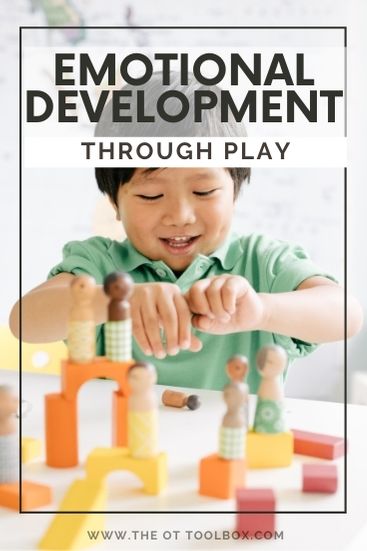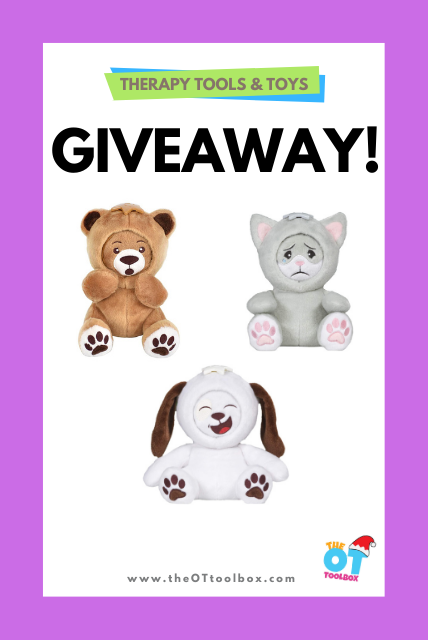Today, I’m excited to share information on emotional development toys that you can add to your emotional skills toolbox! Occupational therapy toys are used to develop skills through play and emotional development is just one of those areas. Toys and play are powerful tools to teach children about emotions. Add these emotional skills toys to support social emotional learning in kids.

Emotional Development Toys
When you take a look at social emotional skills, there is a lot to it! Emotional development contributes to one’s ability to regulate behaviors, participate in learning or social situations, make and keep friends, and management of emotions in everyday situations. Also, social emotional development is a precursor to learning and has been linked to academic performance.
Here are more friendship activities to use as well in promoting development of these skills.
Emotional development occurs from a very young age. In fact, social emotional learning develops from infancy!
This site has some great graphics that break down development of emotional skills by age.
Social Emotional Development Examples
When you think of emotional development, you probably think about a child’s ability to react and respond to situations with emotional maturity. But, in fact, that part of emotional development occurs much later in childhood. Social emotional development looks like many things leading up to emotional maturity!
Emotional development examples include things such as:
- Facial expressions in response to interactions
- Positive attachments at the infants and toddler stage
- Eye contact (but not always an indicator for all children)
- Identifying different expressions in others
- Identifying and labeling emotions based on words, expressions, actions in others
- Identifying emotions and feelings in self based on situations or responses to situation
- Paying attention and using self-control
- Expression of a variety of emotions
- Copying facial expressions
- Uses words to express feelings
- Empathy for others (with sequential progression through the stages of empathy development)
- Having and recovering from temper tantrums
- Pretend play with emotions
- Using and identifying a variety of emotions
- Making friends
- Social awareness
- Positive self-image
- Healthy self-talk or inner voice
- Managing emotions
- Emotional regulation
- Asks for help when needed
- Impulse control in social situations
- Identifying emotions in the situation and responding with functional regulation strategies
How to support emotional development
There are many ways to support social emotional skills using emotional development toys and activities. Some examples include modeling emotional regulation and strategies a child can use. Using describing language to put words to emotions and feelings is another strategy parents can use to support emotional development.
One important way to support a child’s social emotional skills is through play.
Play and emotional development
Through play, it is possible to identify emotions, practice emotions, model interactions, and show empathy. Play offers the chance for children to practice skills in a “safe” environment.
Try this free social emotional learning worksheet with children to help them identify emotions.
Children can learn so much about emotional development through play! Try these strategies to use play as a medium for developing social emotional skills:
- Use imaginative play to practice emotions and responses- Imaginative play offers a variety of situations where emotions, feelings, empathy, and responses can be practiced. Practicing emotions, language, and regulation strategies by playing “house”, doctor, school, shopping, pretend kitchen, or pretend construction, or any other pretend play environment offers so many opportunities for development of skills.
- Play games to build emotional skills- Games offer children the chance to win or lose, where they can respond to that status in different ways. This offers a great opportunity to talk about expectations, impulse control, attention, turn-taking, expectations, and responding to other’s wins or losses.
A printable set of emotions play dough mats can be used to build emotional skills in kids, through play.
- Read books to support emotional development- Books offer a chance to put yourself in another’s place. Reading books with children offers an opportunity to open up conversations on how a character acted in a situation and what the child might have done in that situation. It’s a great way to practice social responses, empathy, and self-regulation strategies. Here are great children’s books (and fun activities based on the books) related to social emotional learning:
- Quick as a Cricket empathy activity
- Beautiful Oops differences activity
- I Ain’t Gonna Paint No More emotions activity
- The Day the Crayons Quit differences activity
- Ish self-acceptance activity
- Little Blue and Little Yellow emotional development book
- Elmer accepting differences activity
- The Kissing Hand emotions activity
Exploring Books Through Play uses children’s literature as a theme to engage in fun, hands-on activities that help children and adults delve deeper into the characters and lessons, bringing the stories to life and falling further in love with literature. Read a story and then bring the characters to life while learning and building skills. Each story offers unique activities designed around central themes of friendship, empathy, and compassion.
Each chapter in Exploring Books through Play includes 5 activities for each of the 10 children’s books. The activities are perfect for children ages 3-8, can be used in small groups or as a whole class, and are easily adapted to a home or classroom setting.
- Talk about choices, emotions, and responses in play- Using play as a means to work on development of these skills. Play offers a chance for children to make choices and opens opportunities to practice sensory regulation strategies for emotional responses.
- Use emotional development toys– Toys that offer a way for children to identify facial expressions, practice empathy in imaginative play, and the opportunity to practice regulation are powerful tools.
Want to help kids learn more about complex concepts such emotions, empathy, compassion, and differences?
Whatsitsface Emotional Development Toy
Recently, I came across the Whatsitsface plush toy on Instagram. This emotional development toy helps children develop emotions through imaginative play. Kids can adjust the moveable parts to change the toy’s facial expression and practice emotional development skills through play.
Kids can practice their understanding of emotions in a safe and interactive way. Whatsitsface allows children to put emotions into a language they understand and provides a chance to practice management of emotions.
The plush emotional development toy has 6 different facial expressions that children can easily change themselves in two different ways.
Check out the blog comments below to learn about reader strategies for teaching children about emotions and emotional development.

Colleen Beck, OTR/L has been an occupational therapist since 2000, working in school-based, hand therapy, outpatient peds, EI, and SNF. Colleen created The OT Toolbox to inspire therapists, teachers, and parents with easy and fun tools to help children thrive. Read her story about going from an OT making $3/hour (after paying for kids’ childcare) to a full-time OT resource creator for millions of readers. Want to collaborate? Send an email to contact@theottoolbox.com.



